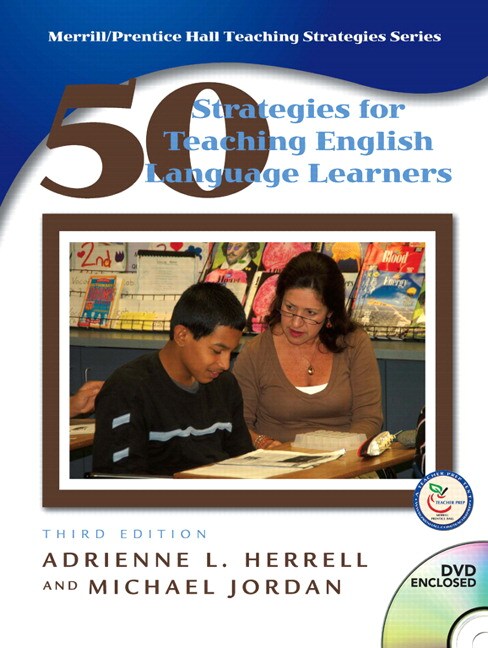
30.00$
Table of Contents
SECTION I Theoretical Overview
SECTION II Strategies for Enhancing Instruction Through Planning
Chapter 1 Predictable Routines and Signals: Reducing Anxiety
Chapter 2 Visual Scaffolding: Providing Language Support Through Visual Images
Chapter 3 Realia Strategies: Connecting Language Acquisition to the Real World
Chapter 4 Interactive Read-Aloud: Reading Designed to Support Understanding
Chapter 5 Advance Organizers: Getting the Mind in Gear for Instruction
Chapter 6 Preview/Review: Building Vocabulary and Concepts to Support Understanding
Chapter 7 Language Focus Lessons: Planning Lessons to Support the Acquisition of English Vocabulary and Structures
Chapter 8 Academic Language Scaffolding: Supporting Student Use of Language in Academic Settings
Chapter 9 Language Framework Planning: Creating a Framework Language Success
Chapter 10 Skills Grouping: Planning for More Individualized Instruction
SECTION III Strategies for Supporting Student Involvement
Chapter 11 Total Physical Response: Integrating Movement into Language Acquisition
Chapter 12 Shared Reading: Demonstrating How Reading Works
Chapter 13 Leveled Questions: Adjusting Questioning Strategies to the Language Levels of Students
Chapter 14 Manipulative Strategies: Using Objects to Connect Concepts
Chapter 15 Partner Work: Practicing Verbal Interaction
Chapter 16 Communication Games: Creating Opportunities for Verbal Interaction
Chapter 17 Bilingual Books and Labels: Supporting Biliteracy Awareness
Chapter 18 Cooperative Learning: Group Interactions to Accomplish Goals
Chapter 19 Culture Studies: Learning Research Skills and Valuing Home Cultures in One Project
Chapter 20 Learning Centers: Extending Learning Through Hands-On Practice
Chapter 21 Imaging: Creating Visual Pictures to Support Understanding
Chapter 22 Integrated Curriculum Projects: Using Authentic Projects to Bring Knowledge Together
Chapter 23 Sorting Activities: Organizing Information into Categories
Chapter 24 Collaborative Reading: What to Do When They Can't Read the Textbook
Chapter 25 Multimedia Presentations: Oral Reports for the New Millennium
Chapter 26 Reciprocal Teaching: Group Work with an Interactive Structure
SECTION IV Strategies for Building Vocabulary and Fluency
Chapter 27 Modeled Talk: Showing While You Talk
Chapter 28 Reporting Back: Verbal Practice in Curricular Connections
Chapter 29 Vocabulary Role Play: Building Vocabulary Through Dramatization
Chapter 30 Vocabulary Processing: A Multistrategy Approach to Building and Using Vocabulary
Chapter 31 Word Walls: Displaying and Organizing Wordsfor Easy Access
Chapter 32 Story Reenactment: Making Stories Come to Life!
Chapter 33 Scripting: Practicing Verbal Interactions
Chapter 34 Practicing Verbal Communication to Build Confidence, Vocabulary, and Comprehension
Chapter 35 Writing Workshop: Supporting the Acquisition of English Writing Competence
SECTION V Strategies for Building Comprehension
Chapter 36 Read-Aloud Plus: Supporting Understanding While Teaching Comprehension Strategies
Chapter 37 Language Experience Approach: Building on an Experience to Create a Written Account
Chapter 38 Interactive Writing: Developing Writing Skills Through Active Scaffolding
Chapter 39 Guided Reading: Providing Individual Support Within a Group Setting
Chapter 40 Interactive Comprehension Building: Using Technology to Build Background Knowledge
Chapter 41 Cloze: Using Context to Create Meaning
Chapter 42 Attribute Charting: Organizing Information to Support Understanding
Chapter 43 Cohesion Links: Understanding the Glue That Holds Paragraphs Together
Chapter 44 Learning Strategy Instruction: Acquiring Self-Help Skills
Chapter 45 Dictoglos: A Strategy for Improving Listening and Oral Communication Skills
Chapter 46 Free Voluntary Reading: Nothing Helps Reading Like Reading
Chapter 47 Repetition and Innovation: Getting to Deep Comprehension Through Multiple Interactions with a Book
Chapter 48 GIST: Exploring Tough Text
Chapter 49 Syntax Surgery: Visually Manipulating English Grammar
Chapter 50 Multiple Intelligences Strategies: Teaching and Testing to Student-Preferred Learning Modes
Teacher Resources
An Informal Multiple Intelligences Survey
English Language Development Profiles
***THIS IS NOT THE ACTUAL BOOK. YOU ARE BUYING the Test Bank in e-version of the following book***
Fifty Strategies for Teaching English Language Learners, 3rd Edition PDF Manual Solutions , PDF Fifty Strategies for Teaching English Language Learners, 3rd Edition , Fast Download Fifty Strategies for Teaching English Language Learners, 3rd Edition , Adrienne L. Herrell, Florida State University Michael L. Jordan, California State University, Fresno,Category : Higher Education

0 commentaires:
Enregistrer un commentaire